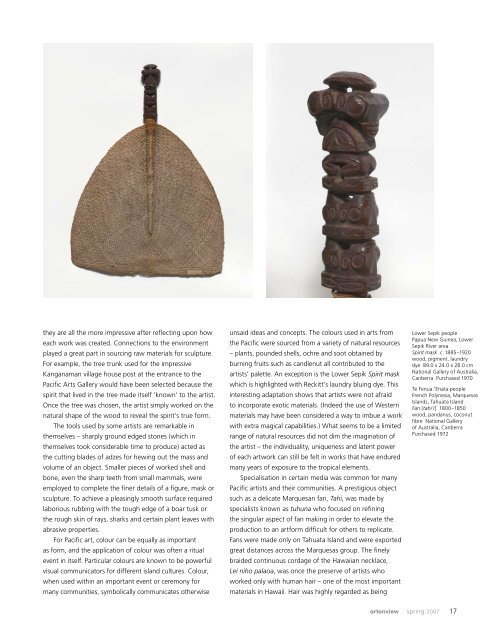Art Ew - National Gallery of Australia
Art Ew - National Gallery of Australia
Art Ew - National Gallery of Australia
You also want an ePaper? Increase the reach of your titles
YUMPU automatically turns print PDFs into web optimized ePapers that Google loves.
they are all the more impressive after reflecting upon how<br />
each work was created. Connections to the environment<br />
played a great part in sourcing raw materials for sculpture.<br />
For example, the tree trunk used for the impressive<br />
Kanganaman village house post at the entrance to the<br />
Pacific <strong>Art</strong>s <strong>Gallery</strong> would have been selected because the<br />
spirit that lived in the tree made itself ‘known’ to the artist.<br />
Once the tree was chosen, the artist simply worked on the<br />
natural shape <strong>of</strong> the wood to reveal the spirit’s true form.<br />
The tools used by some artists are remarkable in<br />
themselves – sharply ground edged stones (which in<br />
themselves took considerable time to produce) acted as<br />
the cutting blades <strong>of</strong> adzes for hewing out the mass and<br />
volume <strong>of</strong> an object. Smaller pieces <strong>of</strong> worked shell and<br />
bone, even the sharp teeth from small mammals, were<br />
employed to complete the finer details <strong>of</strong> a figure, mask or<br />
sculpture. To achieve a pleasingly smooth surface required<br />
laborious rubbing with the tough edge <strong>of</strong> a boar tusk or<br />
the rough skin <strong>of</strong> rays, sharks and certain plant leaves with<br />
abrasive properties.<br />
For Pacific art, colour can be equally as important<br />
as form, and the application <strong>of</strong> colour was <strong>of</strong>ten a ritual<br />
event in itself. Particular colours are known to be powerful<br />
visual communicators for different island cultures. Colour,<br />
when used within an important event or ceremony for<br />
many communities, symbolically communicates otherwise<br />
unsaid ideas and concepts. The colours used in arts from<br />
the Pacific were sourced from a variety <strong>of</strong> natural resources<br />
– plants, pounded shells, ochre and soot obtained by<br />
burning fruits such as candlenut all contributed to the<br />
artists’ palette. An exception is the Lower Sepik Spirit mask<br />
which is highlighted with Reckitt’s laundry bluing dye. This<br />
interesting adaptation shows that artists were not afraid<br />
to incorporate exotic materials. (Indeed the use <strong>of</strong> Western<br />
materials may have been considered a way to imbue a work<br />
with extra magical capabilities.) What seems to be a limited<br />
range <strong>of</strong> natural resources did not dim the imagination <strong>of</strong><br />
the artist – the individuality, uniqueness and latent power<br />
<strong>of</strong> each artwork can still be felt in works that have endured<br />
many years <strong>of</strong> exposure to the tropical elements.<br />
Specialisation in certain media was common for many<br />
Pacific artists and their communities. A prestigious object<br />
such as a delicate Marquesan fan, Tahi, was made by<br />
specialists known as tuhuna who focused on refining<br />
the singular aspect <strong>of</strong> fan making in order to elevate the<br />
production to an artform difficult for others to replicate.<br />
Fans were made only on Tahuata Island and were exported<br />
great distances across the Marquesas group. The finely<br />
braided continuous cordage <strong>of</strong> the Hawaiian necklace,<br />
Lei niho palaoa, was once the preserve <strong>of</strong> artists who<br />
worked only with human hair – one <strong>of</strong> the most important<br />
materials in Hawaii. Hair was highly regarded as being<br />
Lower Sepik people<br />
Papua New Guinea, Lower<br />
Sepik River area<br />
Spirit mask c. 1885–1920<br />
wood, pigment, laundry<br />
dye 89.0 x 24.0 x 28.0 cm<br />
<strong>National</strong> <strong>Gallery</strong> <strong>of</strong> <strong>Australia</strong>,<br />
Canberra Purchased 1970<br />
Te Fenua ‘Enata people<br />
French Polynesia, Marquesas<br />
Islands, Tahuata Island<br />
Fan [tahi’i] 1800–1850<br />
wood, pandanus, coconut<br />
fibre <strong>National</strong> <strong>Gallery</strong><br />
<strong>of</strong> <strong>Australia</strong>, Canberra<br />
Purchased 1972<br />
artonview spring 2007 17

















